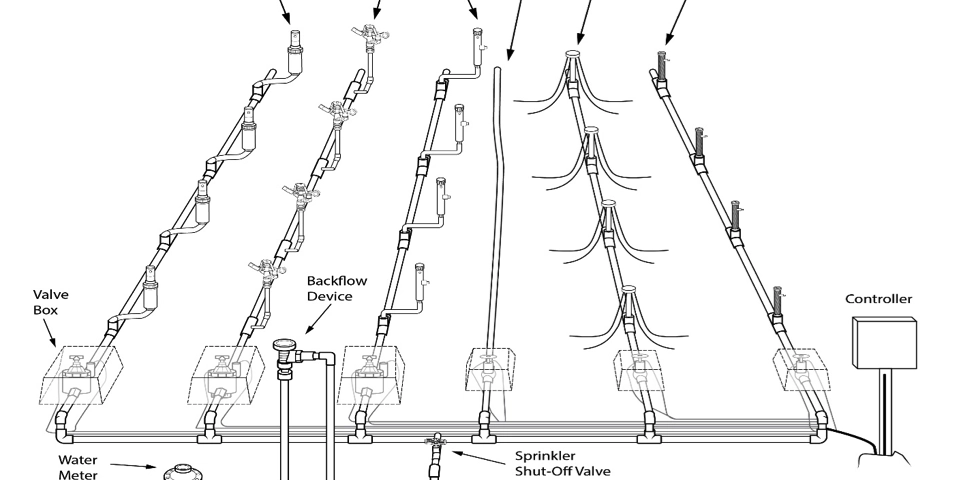
There is no typical homeowner association irrigation system. Some homeowner associations will have systems at their front entrance. Others will have irrigation systems at their clubhouse and other common areas. Some homeowner associations even have their entire property covered by an irrigation system. Compounding this, there are different system configurations with different types of sprinkler heads and other water delivery devices. Most systems derive water from municipal water providers, and some use source ponds and private wells for water. An all-encompassing review of a typical homeowner association irrigation system is difficult to achieve, so a review of the commonalities is what follows in this article.
One aspect of commonality is almost all irrigation systems are under ground with the exception of the controller. The controller regulates the usage and is sometimes referred to as the clock or timer. An automated controller utilizes basic electronic and hydraulic technology to operate the irrigation system. While there are older manual style controllers still in use, most controllers are automated. Automated controllers electronically regulate water flow with solenoids and valves that can be programmed to open and close throughout the system.
Another apparatus that almost all irrigation systems have is a backflow prevention device. A backflow prevention device, or backflow preventer, is fitted at a cross-connection point to prevent contamination of the drinking water source. With the possible exception of water sourced from non-potable water, such as a pond, a backflow preventer is required. A backflow preventer may even be required for non-municipality type sources such as private wells that are fed from an aquifer. These backflow preventers have inspection and maintenance requirements.
Zones are another commonality found with irrigation systems. Irrigation systems can be configured with one or more zones. A zone is established to provide coverage for a designated landscaped area taking into account the plant life composition. Zone configuration can be based on areas of coverage or water delivery devices (e.g., sprinkler heads vs. bubblers). For operational effectiveness, different delivery devices should not be installed in the same zone. Water pressure capabilities or limitations may also dictate the configuration of zones. High water pressure may allow larger zones, while lower pressure could reduce zone size.
Within homeowner association irrigation systems, the most widely used irrigation heads are pop-ups. There are two types of pop-up sprinkler heads, stationary sprays, and rotating sprays. Rotating spray heads are referred to as rotors. Nozzles are fitted to pop-up spray heads to spray water in specific patterns, such as a quarter, a half, or a full circle. On lawn applications, sprinkler heads are installed in the soil at surface level. When the controller allows water into the zone, the lines are pressurized. This pressure will force the sprinkler head(s) to pop-up above the surface and water the designated area. The pop-up spray head will remain up under this water pressure until the controller closes the valve.
The illustration is not representative of a typical irrigation system. In actual systems, spacing would be tailored to the requirements of the landscape and plant life composition. Typically, the systems found in most homeowner associations only utilize one type of irrigation delivery device, e.g., spray heads or rotors. When systems have multiple types of water delivery devices, there must be zone segregation of the different devices for the system to operate efficiently. For illustration purposes, it presents the different possible operational components that can be part of a sprinkler system. Drip irrigation is represented by the three rows on the right of the illustration.
Drip irrigation, bubblers, drip lines, and drip emitters, are not as common as pop-up sprinklers within most homeowner associations. Of these three drip delivery devices, the flow rate is the primary difference. Drip lines and emitters flow at a low rate, typically less than four gallons per hour. A drip line and emitter are designed to allow water to soak directly into the soil at the line or emitter location. Bubblers are designed to saturate the surface soil and thus flow at a much higher rate than a drip line or emitter. Bubbler systems are commonly placed around shrubs or flower beds.
Irrigation systems should be inspected every year for problems and reviewed for water use efficiencies. This is usually performed by the landscaping company and the landscaping committee. Efficiencies can many times be achieved by evaluating current coverage requirements. When irrigation systems are initially installed, they are configured to cover lawns, plants, and trees; these planting situations can change over time. This is especially the case with large shrubs or trees which may no longer need as much water or possibly even this additional irrigation because of their growth. For example, trees may have grown over time and are now shading areas that were once exposed to direct sunlight. This growth development may eliminate the need for certain sprinkler heads or possibly an entire zone within the system, thus allowing for a reduction in water usage.
One final requirement of irrigation systems in regions of the country subject to freezing temperatures and dormant lawns is winterization of the system. This process is usually performed by the homeowner association’s landscaping company or possibly a specific irrigation system service provider. Most landscaping companies offer winterization with their service contract.
Because of all these irrigation system complexities, the related expenses many times can go beyond a homeowner association’s specific annual budget line item. Even with specific irrigation system line items, a related cost may still appropriately be paid from another category. These can range from other landscaping categories to plumbing categories. Nonetheless, an irrigation system is a costly, but crucial aspect of a homeowner association’s landscaping. WDMC
William Douglas Management, providing excellent management services to HOAs and condominium associations since 1980.
Copyright 2019 William Douglas Management, Inc.


